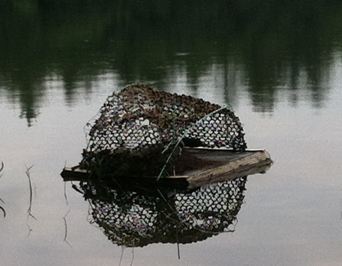Written by Rachael Esh, Interpretive Ranger at White Lake State Park
As a girl coming from the flat plains of Illinois, I was not used to seeing mountains or some of the unique wildlife New England has to offer. Upon arriving to White Lake, I immediately became fascinated by the beautiful scenery, but most of all, a mysterious creature…the loon.

A creature that can easily dive 100 feet under water, White Lake’s deepest depth of 44 feet is no match for the loons. Since loons typically lay one or two eggs near the beginning of June, and they hatch 4 weeks later in July, I had arrived at White Lake just in the nick of time! My excitement led me riding off into the woods on my bike to catch a glimpse of a loon’s nest. Unfortunately, this bike might have been made in the 70s, the tires not in their prime, aiding in my sudden collision with a tree. With all the commotion, I looked up from the bushes to see a cautious loon staring back at me.

My loud and clumsy behavior was clearly unwanted, so I took a quick picture and scurried off. After I survived my bike ride around the lake, I decided to learn what loon calls mean. You can remember the basics with the four letter acronym: WHYT.

Wail: A long, haunting call used between loons to find where his or her partner is. They will call back and forth as they move closer together.
Hoot: A soft, short call to let another loon know where it is. Often used between a chick and its parent.
Yodel: High pitched, repetitive, and loud call made by only male loons. Each has a unique call they use to defend their territory.
Tremolo: Also known as the crazy loon laugh. This could mean a loon is alarmed or excited. Be sure to back away from a loon if you hear this call.

The video below is the tremolo call I recorded after seeing some people get too close in canoes. If you hear this call, or see signs a loon is distressed, increase the distance between you and the loon.
This website from the Loon Preservation Committee can help you hear and compare all of the different loon calls. http://www.loon.org/voice-loon.php
After becoming an expert on loon calls, I waited patiently throughout June for one or two little chicks to hatch in White Lake’s waters. Okay, I lied. I waited impatiently. One week into July, and I was getting restless! Where were these baby chicks?! I tried to forget about it and distract myself by blueberry pickin’ a few days later. While I was out, I heard subtle “hoots” that I had not heard much of before. I peeked through the trees, and much to my afterloon delight, I stumbled upon this new family of 3!

The chick is now about two or three weeks old and you just might see them along the trail if you visit White Lake this summer. If you are intrigued by these birds and want to know how YOU can protect the threatened species in New Hampshire, here are a few tips:
1) Switch to non-lead jigs and sinkers (steel, bismuth/tin, and tungsten). Lead fishing tackle is responsible for 49% of documented New Hampshire adult loon mortalities from 1989-2011, according to the Loon Preservation Committee.
2) Increase distance between you and the loon if you notice unusual behaviors, including:
- Bird ‘dances’ upright on the water, while flapping wings.
- Bird’s neck and body are stretched out low on nest (or on water).
- Bird makes a ‘tremolo’ (laughing sound) or ‘yodel’ call.
3) Spread the word to friends and family about what you’ve learned!

4) Come to White Lake State Park to see and hear the loons! Don’t forget to come to Afterloon Stories and other Interpretive Programs offered this August.
